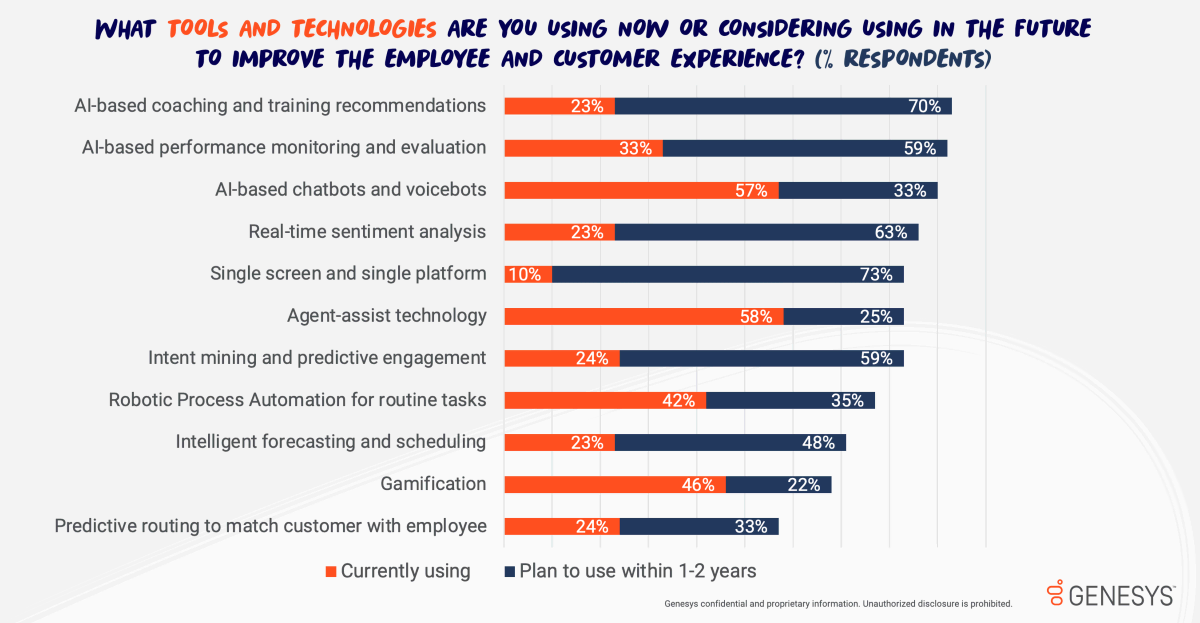Your Genesys Blog Subscription has been confirmed!
Please add genesys@email.genesys.com to your safe sender list to ensure you receive the weekly blog notifications.
Subscribe to our free newsletter and get blog updates in your inbox
Don't Show This Again.

Despite the growth in digital channels for service interactions, voice is still consumers’ preferred touchpoint — closely followed by web chat and email. To keep pace, 72% of customer experience (CX) leaders globally say they expect their numbers of customer support employees to increase over the next two years.
This puts more of a focus on the importance of the employee experience (EX) — treating their frontline team as individuals who make an invaluable impact on the customer experience. Savvy businesses are improving the work environment and personalizing career paths to better leverage employees’ strengths — and set them up for success. The goal: Transform agents into highly skilled employees who can resolve even the most complex customer issues.
But doing so isn’t without obstacles. Three-quarters of business leaders say their top CX challenge is low morale and engagement among their customer experience agents; 78% believe the No. 1 source of agent frustration is having insufficient information in the moment to resolve a customer’s query or problem.
Increasingly, organizations are treating employees more like customers — using a mix of empathy and artificial intelligence (AI) — to improve their experiences. Here are five approaches they’re taking that can lead to greater employee success, satisfaction and retention.
1. Surround employees with AI before, during and after interactions. Leading businesses are leveraging a suite of AI technologies to support CX employees from every angle. They’re using predictive routing to match agents with queries they’re best suited to resolve and surfacing knowledge in real time during interactions to speed issue resolution.
Agent-assist tools give agents more autonomy and improve their decision-making. And solutions like call summarization reduce administrative work. Dashboards and gamification tools give employees access to real-time insights about their performance. Ultimately, employees feel supported and understood, which improves their engagement and satisfaction — and increases retention.

2. Provide personal learning pathways. Leading organizations are already using AI to help build everything from personalized onboarding plans to training and development programs that suit a multigenerational workforce. About one-quarter are currently using AI-based coaching and training recommendations. Another 70% plan to do so within the next two years.
This approach enables supervisors to advise their employees based on analyses of all their interactions, not just a select few. The result is more actionable plans with greater empathy and less subjectivity.
Solutions like real-time sentiment analysis also help organizations provide coaching during interactions. This not only helps CX employees deliver a better experience in the moment, but it also equips them with skills they can apply to future interactions. And that empowers them to take on greater challenges.
3. Support flexible schedules and working environments. Half of CX leaders say they’ve taken a new, more flexible approach to scheduling. Twenty-eight percent plan to do so over the next two years.
These organizations are deploying intelligent scheduling and forecasting tools that allow employees to personalize their shifts and time off. This flexibility leads to improved work-life balance and retention.
Additionally, about 40% of CX leaders say their organization will continue to support hybrid or fully remote working. Even those not offering it believe in the benefits of a flexible work environment: 86% say a hybrid and remote work practice increases employee retention. And 60% say it helps alleviate the stress of a typically demanding job.
4. Rethink success measures. Focusing primarily on efficiency metrics while telling CX employees they need to provide more empathetic customer interactions can lead to stress and frustration. More than 40% of CX leaders see performance metrics as one of the areas in the employee lifecycle with the greatest opportunity for improvement.
Some organizations are moving away from scoring employees on measures like average handle time (though they still track it for forecasting and scheduling purposes). The new paradigm is to gather metrics that are more closely linked to customer retention, such as satisfaction and Net Promoter Score.
5. Bring on the bots. AI-powered chatbots and voicebots can be powerful assets for improving employee engagement. These tools not only can take on rote tasks that can feel repetitive and draining to CX employees, but also can triage interactions and route them to the agents most likely to successfully resolve them.
This more empathetic approach makes employees feel supported. That’s why 57% of organizations are already using these bots to improve the employee experience and another one-third of organizations plan to add them over the next two years.
At a time when 96% of executives say recruiting new employees is their greatest CX challenge, focusing on employee experience — and treating employees as you would your customers — is more important than ever before. Using a blend of AI and empathy to improve EX can lead to greater employee engagement and retention. That contributes to lower hiring and training costs while increasing customer satisfaction, loyalty and lifetime value.
Watch this on-demand webinar to hear the top five ways to accelerate your customer and employee experience in 2024.

Delivering exceptional experiences starts with your employees. A modern cloud architecture with built-in workforce engagement management (WEM) tools makes it easy to create great employee experiences that lead to a better customer experience. See why Genesys made the list.
Subscribe to our free newsletter and get blog updates in your inbox.